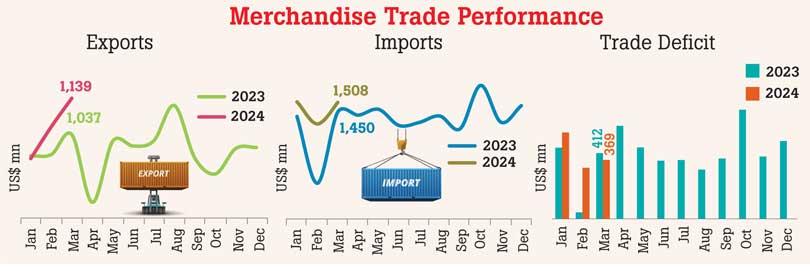
The growth in exports in March outstripped the increase in the expenditure for merchandise imports for the same month, as the exports of textiles and garments showed strength once again, after losing a bit of steam in the recent months.
The data released by the Central Bank showed that Sri Lanka earned US $ 1,139 million in March, the highest since August 2022.
The March exports were up both 9.8 percent and 7.5 percent from a year ago and a month ago levels, respectively, reflecting that Sri Lanka’s exports are ploughing ahead, despite the challenges from the continued rupee strength and somewhat softish growth conditions in the West.
The rupee has strengthened by over 9.0 percent thus far this year, on top of a little over 12 percent appreciation last year against the dollar.
While this bodes positively for the imports and also the softer inflation back home, the continuous rupee strength could lead to threatening the exporters’ competitiveness abroad and also lessening their earnings when converted into rupees.
The March export growth was broad-based and the textile and garment exports recorded US $ 444.9 million, up 6.6 percent from a year ago, reaching the highest level since December 2022.
Meanwhile, the petroleum product exports recorded US $ 92.3 million, up by a robust 134.6 percent. Both garments and petroleum products were the two leading candidates, which drove the industrial product exports by 11.7 percent in March to US $ 912.2 million.
Further, food and beverage and tobacco exports were 65.4 million, up 35.9 percent while the rubber products were at US $ 95.3 million, up 8.9 percent.
Sri Lanka imported goods worth US $ 1,507.7 million, up 4.0 percent from a year earlier and by 9.38 percent from a month ago.
The imports were largely driven by the fuel imports, for which Sri Lanka spent US $ 462.1 million in March, up 18.2 percent from a year ago.
Under imports, other goods, which rose in quantity and value, were machinery and equipment, building materials and food and beverage imports.
This reflects that the people and firms are spending again for consumption and construction in a normalising economy after nearly two years of slowdown.
Under intermediate goods, textiles and textile articles fell by 15.1 percent to US $ 187.9 million in positive signs while the corresponding exports rose.
The non-food consumer goods imports fell by 3.5 percent to US $ 116.5 million, mainly due to the 39.2 percent decline in the imports of medical and pharmaceuticals, which was US $ 41.9 million for the month.
All in all, Sri Lanka recorded a trade deficit of US $ 369 million for March, up from US $ 412 million a year ago and US $ 319 million in February.
The expanding trade deficit reflects the normalising economy and need to worry less, as the robust inflows from remittances and other services inflows such as tourism and IT/BPO services and the sizable inflows from sea transport or freight services more than offset the trade deficit.












